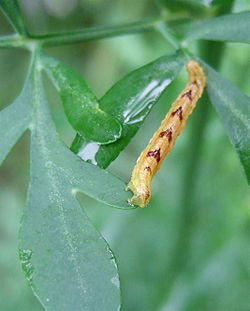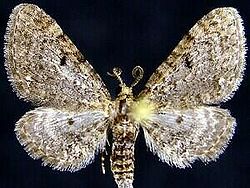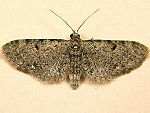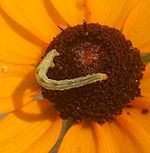Common Eupithecia
| Common Eupithecia |
|---|

|
| Scientific Classification |
|
| Binomial Name |
|
Eupithecia miserulata |
| Common Eupithecia |
The Common Eupithecia is the type species of moth for the genus Eupithecia, of the family Geometridae. This genus has hundreds of different species that can be found in very many parts of the world. [2] The size of the larvae is usually about 15 mm and the full grown moth has a wingspan of about 12-20 mm. [3] The Common Eupithecia overwinter as a pupa, that way they can hatch in the spring. The caterpillars will be found from late summer to early fall, and the moths can be found from March to around November. The miserulata are found mainly in North America, mostly in the western United States.[4] This species only eats plants, while other species in Eupithecia are predatory and will eat other bugs. [5]
Body Design
The bodies of the moth tend to be very slender with broad wings. The wings are typically held out flat with the hind wings revealed, which is much like a butterfly. Males have a frenulum to join the antennae and the wings, usually feathered. While some females have reduced wings, most fly at night, and they tend to match in with their surroundings.[6]
This caterpillar is provided with two appendages at each end of its body for travel. To move, it will grip with its front leg, and will bring up the hind leg. Then it will grip with its hind leg and move forward for another attachment, making it look as if they are measuring their journey. [7]
The coloring of the caterpillar usually varies, but they usually have arrow-like designs where the diagonal lines of the body pattern join on the first six or seven abdominal segments. The coloration also frequently blends with that of the the food plant. They tend to be these colors so that it provides them with excellent camouflage from predators. The adult moth is usually gray to grayish brown. They typically have an indistinct pattern, except for the prominent discal dot. The hind wings and the fore wings have about the same coloration, and have a discal spot. The underside of the body and wings looks very alike to the upper side, but with small differences such as the spotting varies from faint to standing out.[8]
The size of the larvae is usually about 15 mm and the full grown moth has a wingspan of about 12-20 mm.[9]
Life Cycle
Once the moths have mated, the female will deposit the eggs upon a plant. This plant will later become a food source for the caterpillar once it has hatched. The larval stage begins when the development inside the egg has been completed, and a larva is hatched from the egg. Usually for the first meal it will eat its own eggshell, which provides the proper nutrients it needs; but from then on it will eat its host plant. This larva will continue the cycle of eating, excreting, then molting until it is ready to pupate. It also must find a properly suited plant that it can prepare to pupate. It will then shed its final larval cuticle and produce a thinker more stronger pupal skin. [10]
The Common Eupithecia overwinters as a pupa, which means they enter the pupal stage during the winter so that they can emerge as a moth adult during the spring. [11]
The adult will then emerge from the pupal cuticle. It will then prepare to fly for the first time. After that, it will fly in search of a mate so that it can reproduce and restart the life cycle. [12]
Ecology
Diet
The caterpillar's main job is to eat so that it can grow larger and be prepared for when it will wrap itself in a cocoon and grow into a moth. These larvae mostly eat aster, clover, coneflower, hoptree, juniper, wild black cherry, and willow.[13]
Location and Season
Common Eupithecias are usually found in many parts of North America. They have been found from Nova Scotia to Florida, west to Texas, north to Ontario. Also found in the western United States in states like Arizona, California, and up to Washington. Caterpillars are usually found from late summer until fall. The adults, however, fly most of the year in the northern area from March to November. Most likely they fly all year in the south.[14]
The Genus Eupithecia
Eupithecia is a large group of moths that can be found all around the world, and more species are being found on a fairly common basis. The genus comes from the family Geometridae, and there are hundreds of described species. The common name for the species is sometimes known as pug. As a whole, Eupithecias tend to be small and have subtle colors. This makes it fairly difficult to reconize the specific species. As a group, however, they can easily be recognized by their confined wings and the fact that the wings themselves are held flat to their body. [15]
Some species from Eupithecia are predators even. Commonly found on the Hawaiian islands, the Hawaiian Eupithecia mimic twigs with hairs on their back. When touched, it will trigger them to eat whatever insect is crossing along its back. [16]
References
- McLeod, Robin. Species Eupithecia miserulata - Common Eupithecia - Hodges#7474. BugGuide. Web. January 19, 2005. Last updated October 13. 2011.
- Common Eupithecia Moth Caterpillar | Eupithecia miserulata. Cirrus. Web. Accessed November 7th 2011. Author Unknown.
- Bug Info. Encyclopedia Smithsonian. Web.Accessed November 16th 2011.
- Hadley, Debbie. Life Cycle of Butterflies and Moths. About.com Insects. Web.Accessed November 16th 2011.
- Eupithecia. EOL: Encyclopedia of Life. Web. Accessed November 17th 2011. Author Unknown.



